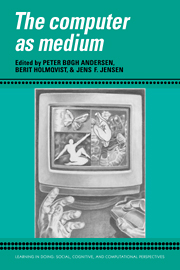Book contents
- Frontmatter
- Contents
- Series foreword
- Preface
- Contributors
- Part I Computer-based signs
- Part II The rhetoric of interactive media
- Introduction
- 6 Narrative computer systems: The dialectics of emotion and formalism
- 7 Interactive fiction: Artificial intelligence as a mode of sign production
- 8 Plays, theaters, and the art of acting in the eighteenth century: A formal analysis
- 9 The meaning of plot and narrative
- 10 Face to interface
- 11 Drawing and programming
- 12 Hypermedia communication and academic discourse: Some speculations on a future genre
- Part III Computers in context
- Index
6 - Narrative computer systems: The dialectics of emotion and formalism
Published online by Cambridge University Press: 05 October 2010
- Frontmatter
- Contents
- Series foreword
- Preface
- Contributors
- Part I Computer-based signs
- Part II The rhetoric of interactive media
- Introduction
- 6 Narrative computer systems: The dialectics of emotion and formalism
- 7 Interactive fiction: Artificial intelligence as a mode of sign production
- 8 Plays, theaters, and the art of acting in the eighteenth century: A formal analysis
- 9 The meaning of plot and narrative
- 10 Face to interface
- 11 Drawing and programming
- 12 Hypermedia communication and academic discourse: Some speculations on a future genre
- Part III Computers in context
- Index
Summary
For a long time we were occupied with computers as media in a metaphorical sense, for evaluating such system types as graphical systems, filing systems, or process control systems. In 1989, however, we started to take the media perspective in its literal sense. We wanted to use the computer like a real medium, such as film, television and theater, to create art. Although there are many similarities between other arts and systems design, there is one fundamental difference: Interaction plays an important part in the computer medium, whereas it is absent in other media.
To make our intention clear, we began a project where we used the computer to create interactive fiction. As distinct from more tool-like systems we wanted to define a new class of systems that we called “narrative systems.” The characteristic feature of these systems is that their main purpose is communication, so their functionality is almost the same as the interface.
Examples are teaching systems, databases, mail systems, and video games. Our purpose was to answer the following questions:
What kinds of techniques are useful for telling a story where interaction is a fundamental part?
What kinds of methods are the optimal ones for systems development?
Could we discover more general narrative techniques that can be used in non-fiction applications, such as data bases and teaching systems.
Information
- Type
- Chapter
- Information
- The Computer as Medium , pp. 148 - 168Publisher: Cambridge University PressPrint publication year: 1994
